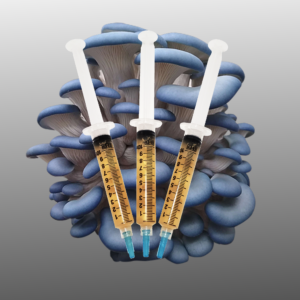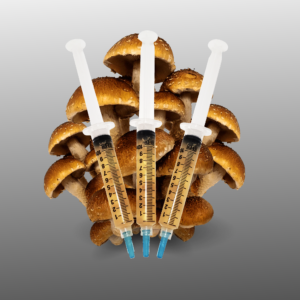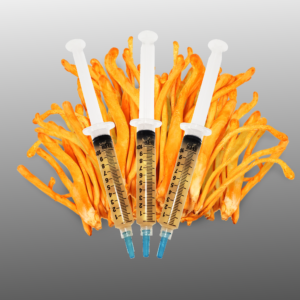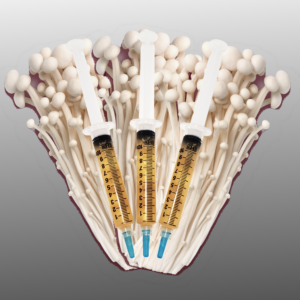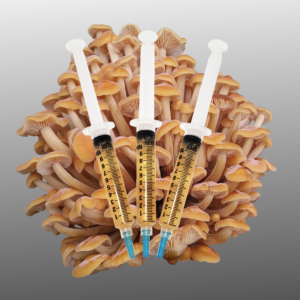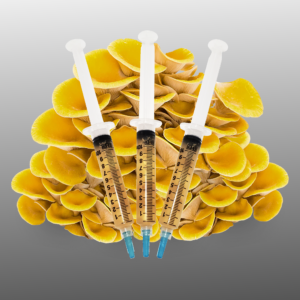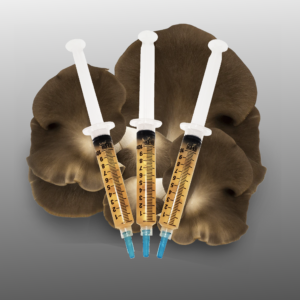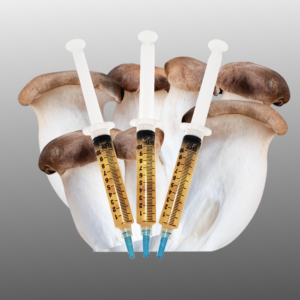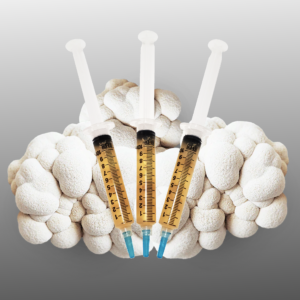Table of Contents:
1. What is Liquid Culture?
2. Pros and Cons of Liquid Culture
3. Making Liquid Culture
4. How Liquid Culture Grows
5. Using Liquid Culture: The Right Amount
6. Storing Your Liquid Culture
1. What is Liquid Culture?Liquid culture is a method used in mushroom cultivation to grow mushroom mycelium, which is the thread-like, vegetative part of a mushroom. It involves creating a special liquid mixture that provides all the necessary nutrients for the mycelium to grow and thrive. This mycelium can later be used to inoculate other substrates, such as grains or bulk substrates, to produce mushrooms. Liquid culture is a quick and efficient way to propagate mushroom mycelium and is often used by mushroom cultivators to expand their mushroom cultures.
2. Pros and Cons of Liquid Culture
Let’s explore the advantages and disadvantages of using liquid culture in mushroom cultivation:
Pros:
• Liquid culture is a speedy and uncomplicated way to grow mushroom mycelium.
• You can create a large amount of liquid culture from just a small amount of mycelium.
• It’s simple to share with fellow mushroom enthusiasts or store for future use.
Cons:
• Occasionally, liquid culture can become contaminated with unwanted microorganisms.
• It may not be suitable for all types of mushrooms.
3. Making Liquid Culture
Here’s a detailed guide on how to create your own liquid culture:
Preparing liquid culture for mushroom cultivation typically involves a few common ingredients and recipes. Here’s a basic recipe for creating liquid culture:
Ingredients:
1. Water: Use distilled or dechlorinated water to prevent unwanted contaminants. Tap water can be left out overnight to allow chlorine to dissipate.
2. Light Corn Syrup or Malt Extract: These serve as a source of easily digestible sugars for the mushroom mycelium. You can choose either, depending on availability and preference.
While corn syrup and malt extract are commonly used as supplements in liquid culture recipes for mushroom cultivation, there are alternative ingredients and supplements you can explore based on your preferences and availability. Here are a few alternatives:
Honey: Honey can serve as a natural sugar source for liquid culture. It provides essential nutrients for mycelium growth and is often used by mushroom cultivators. However, it can be a bit more challenging to work with due to its thickness.
Karo Syrup: Karo syrup is another sugar-based alternative to corn syrup. It is available in various flavors, with the light version being a popular choice for liquid culture.
Agave Nectar: Agave nectar, a natural sweetener, can be used in place of corn syrup or malt extract. It’s a liquid sweetener that is readily available and can support mycelium growth.
Brown Sugar: Brown sugar can be dissolved in water to create a sugar solution for liquid culture. It provides a source of carbohydrates for the mycelium to thrive.
Potato Extract: Potato extract is occasionally used as a nutrient source for liquid culture. To prepare it, boil and mash potatoes, then use the starchy water as a base for the liquid culture.
Dextrose: Dextrose, a simple sugar, can be employed in liquid culture recipes. It’s highly soluble and can be found at brewing supply stores or online.
When selecting an alternative nutrient source for your agar plates, it’s essential to consider the nutritional needs and preferences of the specific fungal species you are working with. Different fungi may thrive on different substrates, and using the right nutrient source can contribute to successful cultivation. Always sterilize the nutrient source, agar mixture, and equipment to prevent contamination during the preparation of agar plates.
When preparing liquid culture for mycology, you can use a variety of nutrient sources to support the growth of fungi. Here’s a list of alternative ingredients for liquid culture:
Malt Extract: Malt extract is a common and versatile nutrient source for liquid culture. It provides essential sugars, amino acids, and vitamins for fungal growth.
Potato Dextrose: Potato dextrose is another standard nutrient source for liquid culture. It offers a mix of carbohydrates and nutrients suitable for many fungi.
Honey: Honey can be used to provide sugars and additional nutrients. It is particularly suitable for fungi that thrive on sugar-rich substrates.
Agave Nectar: Agave nectar is a natural sweetener that can serve as a sugar source in liquid culture. It’s suitable for certain fungi.
Karo Syrup (Corn Syrup): Karo syrup, a type of corn syrup, is rich in sugars and can support the growth of fungi that prefer sugar-based substrates.
Soy Peptone: Soy peptone is derived from soy protein and provides a source of amino acids and nitrogen, which are essential for fungal growth.
Yeast Extract: Yeast extract offers a concentrated source of amino acids and essential nutrients for fungi. It’s often used in combination with other ingredients.
Dextrose (Glucose): Dextrose, also known as glucose, is a simple sugar that can be used as a primary carbohydrate source in liquid culture.
Potato Flakes: Potato flakes can be processed into a liquid culture medium. They provide carbohydrates and nutrients suitable for specific fungi.
Brown Rice Syrup: Brown rice syrup can serve as a sugar source for liquid culture, particularly for fungi that thrive on complex carbohydrates.
Fruit Juice: Fruit juices like apple or orange juice can be used to provide natural sugars and nutrients in liquid culture.
Cereal-Based Extracts: Extracts from cereals like rice or wheat can offer a unique nutritional profile for liquid culture.
Vitamin Supplements: Some fungi may require specific vitamins for growth. Vitamin supplements can be added to ensure nutritional adequacy.
Seaweed Extracts: Seaweed extracts, such as kelp or dulse extracts, can serve as nutrient sources in liquid culture, providing a different nutritional profile.
When preparing liquid culture, it’s crucial to select the right nutrient source based on the nutritional preferences of the specific fungal species you are working with. The choice of nutrient source can impact the success of your culture. Proper sterilization and aseptic techniques are essential to prevent contamination during liquid culture preparation.
Selecting an alternative to corn syrup or malt extract, it’s essential to ensure that the chosen supplement is free from contaminants and additives. The primary goal is to provide a clean and nutritious environment for the mushroom mycelium to flourish. Experimenting with different sugar sources may help you discover what works best for your specific mushroom cultivation needs.
3. Mason Jars or Glass Containers: Sterilizable glass containers with lids for holding the liquid culture.While some plastics can withstand the heat and pressure inside a pressure cooker, it’s crucial to use only specific types of high-temperature-resistant plastics for mushroom cultivation and sterilization. The use of plastics in a pressure cooker can vary depending on their heat tolerance and intended application. Here are some considerations:
Polypropylene (PP): Polypropylene plastic is one of the few plastics that can withstand the heat and pressure of a pressure cooker. It’s often used in the form of autoclave bags or containers for sterilizing substrates and materials. Ensure that the plastic is labeled as heat-resistant or suitable for autoclaving.
Polyethylene (PE): High-density polyethylene (HDPE) is another plastic that can handle high temperatures. It’s used in the form of bags, buckets, or containers for preparing and sterilizing substrates. Like polypropylene, it should be labeled as heat-resistant.
Polyester (PET): Polyester plastic, particularly the heat-resistant PET type, can also be used for creating bags or containers for sterilization in a pressure cooker. Check that the PET plastic is designed for high-temperature use.
Polyamide (Nylon): Some types of nylon, such as nylon 6/6 or nylon 6, can be heat-resistant and are occasionally used in laboratory settings for sterilizing materials. However, their heat resistance may vary, so be sure to check the specifications.
It’s essential to verify the heat resistance of any plastic you plan to use in a pressure cooker and ensure it’s safe for the intended application. Always follow the manufacturer’s guidelines and recommendations for the specific pressure cooker you are using to avoid any safety risks or damage to the equipment. Additionally, remember that even heat-resistant plastics should not come into direct contact with open flames or heating elements.
4. Mushroom Spores or Mycelium: Your selected mushroom spores or mycelium culture to inoculate the liquid culture.Recipe:
1. Prepare the Liquid: For every liter of water, add approximately 20-30 grams of light corn syrup or malt extract. Mix it well to dissolve the sugar completely. This sweet liquid will provide the necessary nutrients for mycelium growth.
2. Sterilization: Pour the sweetened water into the glass containers, leaving some space at the top. Seal the containers with lids.
3. Pressure Cooking or Boiling: Sterilize the containers and their contents by using a pressure cooker or by boiling them for about 15-20 minutes. This step is crucial to eliminate any unwanted contaminants.
4. Inoculation: After sterilization, allow the containers to cool down. When they reach room temperature, add a small amount of mushroom spores or mycelium culture into the liquid using a sterile syringe or pipette. Seal the containers with the lids.
5. Incubation: Place the inoculated containers in a warm and dark location, typically around 75-80°F (24-27°C). The mycelium will gradually grow and spread throughout the liquid culture. This process can take a few weeks.
6. Storage: Store the liquid culture in a clean and cool place when it’s not in use. It can stay viable for several months if stored properly.
The specific proportions of water and sugar, as well as the sterilization times, can vary based on the mushroom species and the individual preferences of mushroom cultivators. It’s crucial to maintain a clean and sterile environment throughout the process to prevent contamination.
4. How Liquid Culture GrowsIn a liquid culture, mycelium grows by consuming the nutrients provided in the liquid. The mycelium is introduced into the liquid culture, usually in the form of spores or mycelium tissue, and it begins to colonize and expand as it feeds on the nutrients.
Here’s how mycelium grows in a liquid culture:
1. Inoculation: The process begins with the introduction of a small amount of mycelium or spores into the sterilized liquid culture medium. This inoculation provides the initial “seed” for mycelium growth.
2. Nutrient Uptake: The mycelium consumes the available nutrients in the liquid, such as sugars, carbohydrates, and other essential elements. These nutrients act as food for the mycelium, allowing it to grow and reproduce.
3. Mycelial Growth: As the mycelium feeds on the nutrients, it forms a network of thread-like structures known as mycelium. This mycelial network expands and spreads throughout the liquid culture medium.
4. Colonization: Over time, the mycelium continues to colonize the entire volume of the liquid culture. The speed of colonization can vary depending on factors like the type of mushroom, the temperature, and the concentration of nutrients in the liquid.
The time it takes for mycelium to fully colonize a liquid culture can range from a few weeks to a couple of months, depending on the specific conditions and mushroom species.
Common tools and equipment used in the production of liquid culture include:
Mason Jars or Glass Containers: These are used to hold the liquid culture during sterilization and incubation.
Pressure Cooker or Autoclave: These are essential for sterilizing the liquid culture medium and containers to prevent contamination.
Laminar Flow Hood or Still-Air-Box: These provide a sterile workspace for handling the liquid culture and inoculating it with mycelium.
Agar Plates or Petri Dishes: These may be used to start the mycelium culture and prepare inoculum.
Stir Bars and Magnetic Stirrers: Stir bars and magnetic stirrers are valuable tools in liquid culture production, as they help maintain a homogeneous environment, preventing settling of mycelium and promoting consistent growth. The speed and duration of stirring can be adjusted to suit the specific requirements of the mushroom species being cultivated
5. Using Liquid Culture: The Right AmountWhen it comes to mushroom cultivation, using liquid culture can be an incredibly efficient and cost-effective method. The key to success with liquid culture is that you don’t need a large volume of it to start a mushroom colony. Even just a tiny drop or a few milliliters of liquid culture can go a long way. Here’s how it works:
Starting with Liquid Culture: Liquid culture is a rich nutrient medium that contains live mycelium, the vegetative part of a mushroom. Mycelium is responsible for colonizing and growing in a substrate. Liquid culture serves as a concentrated source of mycelium, allowing you to inoculate multiple substrates with a small amount.
Using a Drop of Liquid Culture: To start the growth process, you take a small drop or a few milliliters of the liquid culture. This tiny amount contains a vast number of mycelium cells. Think of it as the “magic potion” for mushroom growth.
Inoculating Substrates: You then mix this small amount of liquid culture with a larger quantity of another material, known as a substrate. The substrate can be various materials like grains, sawdust, straw, or any other suitable medium for the specific mushroom species you are cultivating.
Mycelial Growth: The mycelium from the liquid culture begins to colonize the substrate. It spreads through the substrate, consuming the nutrients and forming a web-like network. This is an essential phase of mushroom growth.
Fruiting: Once the substrate is fully colonized by the mycelium, you create the right conditions for fruiting, which usually includes adjusting temperature, humidity, and providing proper lighting. The mycelium then starts to produce mushroom fruiting bodies.
The beauty of this method is that a small volume of liquid culture can inoculate multiple substrates, effectively multiplying your mushroom production potential. This technique is especially valuable for cultivators looking to scale up their mushroom growing efforts. It’s worth noting that the specific amount of liquid culture needed can vary based on the mushroom species, substrate, and desired colonization speed, so you may need to adjust the quantities to suit your specific cultivation goals.
6. Storing Your Liquid CultureIf you find yourself with extra liquid culture, don’t worry; you can save it for future use. Keep it in a clean and sterile place, such as a refrigerator. It can stay viable for several months. When you’re ready to use it, check to ensure that it remains clear and free from contaminants.
Checking Liquid Culture for Contaminants Using Agar:
When you’re planning to reuse stored liquid culture, it’s essential to ensure that it’s still free from contaminants. The use of agar plates can be a valuable tool in this process. Here’s how you can go about it:
Materials Needed:
• Sterile agar plates
• Sterile tools (like a scalpel or inoculation loop)
• A clean and sterile workspace (such as a laminar flow hood or still-air box)
Procedure:
1. Prepare Sterile Agar Plates: First, you need to prepare sterile agar plates. These plates serve as a medium for the growth of microorganisms. Ensure that the agar medium is free from contaminants. You can purchase pre-made agar plates or make your own by sterilizing agar and pouring it into Petri dishes.
2. Inoculation: In a sterile environment, use aseptic techniques to open the stored liquid culture. Take a small sample of the liquid culture using a sterile tool (such as an inoculation loop or scalpel). Carefully streak this sample onto the surface of the agar plate.
3. Incubation: Seal the agar plate and incubate it in a warm and dark place. Allow it some time, typically a few days to a week, depending on the type of contaminants you suspect. This period allows any potential contaminants to grow on the agar medium.
4. Examine the Plate: After the incubation period, carefully examine the agar plate. If the liquid culture was free from contaminants, you should only see the original mycelium growth. However, if there are any unusual or unintended growth, such as mold or bacteria colonies, this indicates contamination.
• Contaminated Culture: If the agar plate shows contamination, it’s best not to use the liquid culture. Discard it to prevent introducing contaminants into your mushroom cultivation process.
• Clean Culture: If the agar plate shows no signs of contamination, the liquid culture is likely still viable and can be used for inoculation in your mushroom cultivation projects.
By using agar plates to check for contamination, you can make an informed decision about the suitability of your stored liquid culture for future use. This process helps maintain the quality and sterility of your mushroom cultivation projects, ensuring successful and healthy mushroom growth.
In summary, liquid culture is a swift and straightforward method for cultivating mushrooms. It offers various benefits, including ease of creation and sharing. However, it’s essential to be cautious about contamination, and not all mushroom types may be suitable for this method. By following the outlined steps and guidelines, you can embark on your journey to growing mushrooms with liquid culture. Happy growing!


